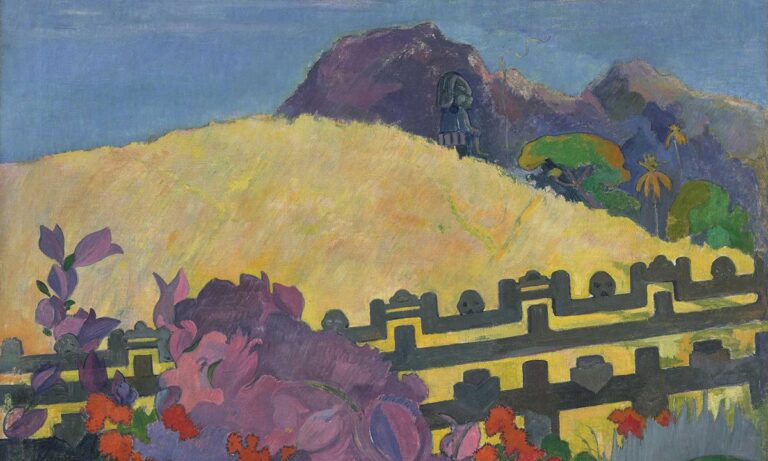
A major survey exhibition dedicated to French post-Impressionist artist Paul Gauguin has opened at the National Gallery of Australia in Canberra. Given that the exhibition’s starting point is Gauguin’s painful final months in self-imposed exile in paradise, it is an investigation in many ways. For Gauguin, this was a strange kind of Eden. He died on May 8, 1903, in the village of Atuona on the lush Marquesa island of French Polynesia, Hiva Oa. He suffered from syphilis and severe eczema, and suffered a broken leg that would not heal and was in unbearable pain.
Curated by Henri Loyrette, Gauguin’s compatriot and former director of the Louvre, the exhibition is titled Gauguin’s world: his own, his world. Gauguin lived in Tahiti for two periods (1891-93 and 1895-1901) before arriving in the Marquesas in September 1901. The subtitle refers to Gauguin in Tahitian language. of the soul, spirit, thoughts and ideas and content that makes up his world.
The exhibition traces the artist’s early life from the picturesque mountain heights of Hiva’ao. It traces Gauguin’s friendship with Camille Pissarro, the so-called father of Impressionism, and charts the artist’s path through traditional Parisian salons and galleries until he left Europe in search of new subjects and greater authenticity. between.
Tahitian title
Loiret visited Tahiti during the exhibition planning process and met with Polynesian and Tahitian scholars and writers. The exhibition catalog contains new information about Gauguin’s use of Tahitian titles for his works.
Tahiti and Marquesan objects on loan for the exhibition include a carved bone and shell headset, whose distinctive geometric pattern can be recognized in the composition of some of Gauguin’s paintings, including Holy Mountain (Prahi Te Marae) (1892), on loan from the Philadelphia Museum of Art. The headphones are on loan from the Quai Branly museum in Paris.
The exhibition, a five-year collaboration between the National Gallery of Australia, the Australian Art Exhibition Bureau and the Museum of Fine Arts, Houston (MFA), will travel later this year. This is the first major Gauguin retrospective to be held in Oceania, the region where the artist’s fiery life ended.
There are 140 works of art from more than 65 public and private collections, including some of Gauguin’s most famous paintings, such as young wrestler (1888) from Louvre Abu Dhabi; Portrait of the Artist with the “Yellow Christ” (1890-91) and Tahiti women (1891) from the Musée d’Orsay, Paris; moon and earth (1893) from the Museum of Modern Art, New York; and three tahitians (1899) From the National Gallery of Scotland. Loiret’s stature in the art world undoubtedly reassured lenders who might otherwise have been reluctant to send Gauguin’s treasure to the southern hemisphere.
The artist’s paintings, engravings, sculptures and decorative arts are also on display here.
“It’s particularly exciting to bring the Gauguin exhibition to the South Pacific, which was so important to him and was clearly his paradise and his obsession,” said Gary Tinterow, director of the Houston Museum of Art. ) said, he has been involved in the preparations for the exhibition.
Tintero emphasizes Gauguin’s influence on Vincent van Gogh, the so-called Nabis (Emile Bernard, Pierre Bonnard, Édouard Vuillard and others) and later artists such as Henri ·Influence of Matisse and Pablo Picasso and the German Expressionists. “If they hadn’t seen and tried to understand the importance of what Gauguin did, they wouldn’t have done what they did,” Tintero said.
Gauguin has been in the spotlight recently for his relationships with young women and girls in Oceania. Tintero said no one had anything to do with the exhibition and called Gauguin a hero. But his position is that art museums are not guardians of public morals. By adopting a strictly dismissive stance, scholars and the public lose the opportunity to develop a nuanced understanding of earlier times and elsewhere.
“Gauguin could be criticized for his actions, and one could fairly do so,” Tintero said. “But we are not doing an exhibition about Gauguin, the promiscuous sailor of the South Seas. That is not what the exhibition is about. The exhibition is about the extraordinary works of art that Gauguin created in Europe, the Caribbean and Polynesia.
• Gauguin’s world: his own, his world, National Gallery of Australia, Canberra, until October 7; Art Gallery of Houston, November 3 to February 2, 2025

